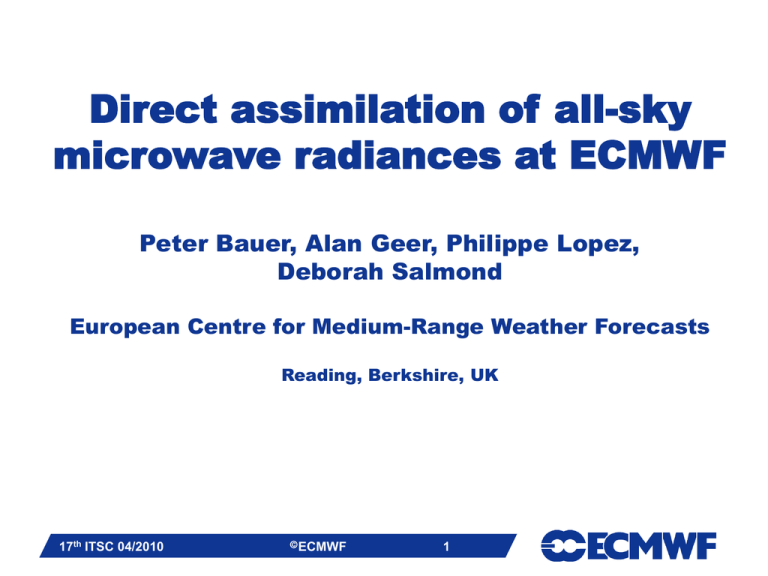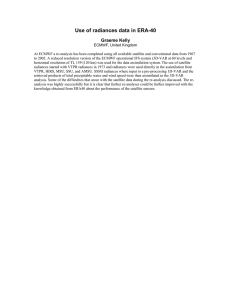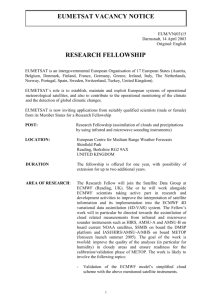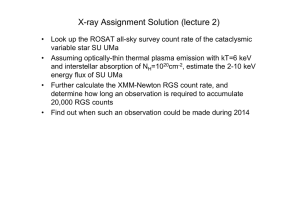Direct assimilation of all-sky microwave radiances at ECMWF Deborah Salmond
advertisement

Direct assimilation of all-sky microwave radiances at ECMWF Peter Bauer, Alan Geer, Philippe Lopez, Deborah Salmond European Centre for Medium-Range Weather Forecasts Reading, Berkshire, UK Slide 1 17th ITSC 04/2010 ⒸECMWF 1 Microwave imager ‘all-sky’ approach MHS Obs-Model mean and standard deviation Clear-clear Cloud-cloud Obs Clear-FG cloud Obs Cloud-FG clear 37 GHz (v) Obs - FG All-sky Slide 2 CTRL In global Numerical Weather Prediction (NWP) systems, satellite observations provide 90-95% of the actively assimilated data. However, over 75% of satellite observations are discarded due to cloud contamination and unknown land, snow and sea-ice surface emissivity. Cloud-affected data is difficult to deal with because of the limited accuracy of moist physics parameterizations in numerical models and the need to model radiative transfer through clouds and precipitation. Errico et al. (2007, JAS, 65, 3348-3350) summarise the most important issues related to the assimilation of cloud and precipitation observations. One prominent problem is the non-linearity (and non-continuity) of models, i.e. the sensitivity of the parameterizations to input parameter perturbations is strongly state dependent. This can cause data assimilation systems to produce erroneous analysis increments in model state variables affecting balance and stability. Slide 3 17th ITSC 04/2010 ⒸECMWF 3 Moreau et al. (2003, QJRMS, 130, 827-852) and Bauer et al. (2006, QJRMS, 132, 2277-2306) have shown that for global models it is preferable to assimilate microwave radiances rather than rain rates because: • the observation operator always produces non-zero gradients (in the absence of signal saturation) whether a scene contains clouds or not; • an observation operator which combines moist physics and radiative transfer model behaves more continuously over its dynamic range than does moist physics alone; • the statistics of observed-minus-modelled radiance departures have mostly Gaussian characteristics, and this also facilitates bias correction; • observation operator errors can be derived from spatial departure covariance statistics. Bauer et al. (2010, QJRMS, submitted) and Geer et al. (2010, QJRMS, submitted) describe improvements in the use of microwave satellite observations in the ECMWF forecasting system. Since March 2009, the operational system has assimilated all-sky microwave radiances directly into 4D-Var. Slide 4 17th ITSC 04/2010 ⒸECMWF 4 All-sky radiance assimilation: • direct radiance assimilation over ocean only; • no spatial interpolation – observations super-obbed to grid points, operators (moist physics and radiative transfer model) applied at grid-point locations; • “all-sky” – all observations (clear, cloudy, rainy) assimilated through the same operator: • this gives balanced sampling, • and allows to create/dissipate/modify clouds similarly. Control Variable / State vector Forecast model State at time i Radiative transfer Radiance observations x0 Mi xi Hi yi J x 0 M Ti J x i H Ti J y i Wind and mass Humidity Clouds and rain Dynamics Moist physics Wind and mass Humidity Clouds and rain Clear, cloud Clear sky and Slide 5 rain including scattering Clear All-skies: sky clear, cloudy and rainy Histograms of SSM/I first-guess radiance departures for samples where both model and observations contain clouds (dotted) or only clearsky (solid), where the observations contain clouds but the model is cloud-free (dash-dotted) and vice versa (dashed) for channels 19v (a), 19h (b), 22v (c), 37v (d), 37h (e), 85v (f), 85h (g). Data drawn from a 12-hour assimilation on 15 September 2007 00 UTC. Slide 6 17th ITSC 04/2010 ⒸECMWF 6 Linearity – single observation test: • A: Convection in the inter-tropical convergence zone (ITCZ): model has too much rain compared to the observation. • B: Mid-latitude cold front: model has too little moisture and cloud. • C: Convection in the ITCZ: a near neighbour to case A, but chosen to illustrate a situation with poor minimisation quality. SSM/I channel 19v first guess departures through the 4D-Var minimisation for singleobservation test cases A, B and C using the allsky approach. Squares indicate departures calculated using the nonlinear T511 forecast model in the `outer loop'; crosses indicate the departure at the end of each minimisations or `inner loop', calculated using the incremental Slide 7 method. Linearity - full system Non-linear vs. linear departures in first inner-loop Rainfall radar (research only) All-sky microwave imagers Slide 8 Clear-sky satellite and conventional Linearity - full system Non-linear vs. linear departures in last inner-loop All-sky microwave imagers Slide 9 NWP model biases – Example: cold sectors Mean SSM/I channel 37v first-guess departures (1st July 2009) ECMWF model cloud liquid water fraction, (liquid + ice)/total Slide 10 NWP model biases – Example: location/width of fronts First guess Observation Departure Slide 11 Mean SSM/I channel 37v radiance departures Mean TCWV increments All-sky (total): 4004937 AllSky - Control 90 a 135 0 15 30 45 -45 -30 -15 45 90 135 6 All-Sky (cloudy): 2603074 b -135 -90 -45 0 45 90 135 -45 -30 -15 0 -15 -30 -45 0 15 30 45 45 30 15 -45 0 45 90 4 -135 -90 -45 0 45 90 b 135 135 -45 -30 -15 0 -15 -30 -45 0 15 30 45 45 30 15 -135 -90 -45 0 45 90 -2 -4 135 -135 -6 -135 -90 -45 0 45 90 0 15 30 45 -45 -30 -15 0 -15 -30 -45 -90 -45 17th ITSC 04/2010 0 45 90 0 45 90 135 6 4 2 135 -90 -45 0 45 90 135 -90 -45 0 45 90 135 135 45 30 15 -135 -45 8 Mean SSM/I channel 37v first-guess departures highlight Slide 12 systematic model cloud deficiencies. The mean TCWV increments show that the moisture climate is similarly affected by 1D+4D-Var (Control) and the all-sky system. ⒸECMWF 12 -2 -4 -6 -135 Control (clear): 763185 d -90 10 0 0 -135 135 AllSky - AllSkyOff 2 All-Sky (clear): 1401863 c 90 0 -15 -30 -45 -60 -75 -90 45 75 60 45 30 15 -135 0 -75 -60 -45 -30 -15 0 FG departure [K] -45 -45 0 -15 -30 -45 -60 -75 0 -15 -30 -45 -90 -90 75 60 45 30 15 45 30 15 -135 -135 -8 -10 TCWV difference [%] 45 15 30 45 60 75 0 0 -45 15 30 45 60 75 -90 0 -135 -75 -60 -45 -30 -15 a Impact verification - satellites a b 12 183±1 HIRS channel number Channel frequency [GHz] 11 183±3 7 6 5 183±7 4 1.0 1.2 1.4 1.6 Std. dev. [K] 1.8 2.0 -1.0 -0.5 0.0 Mean [K] 0.5 1.0 0.4 0.5 0.6 0.7 0.8 0.9 Std. dev. (normalised) 1.0 1.1 -0.6 -0.4 -0.2 0.0 0.2 Mean [K] 0.4 Verification of short-range forecasts (solid) and analyses (dashed) against MHS (left) and HIRS (right) radiance observations over period 1 July-31 October 2009: • no microwave imagers • 1st version of all-sky system Slide 13 • revised version of all-sky system 0.6 Impact verification - sondes c d 100 150 300 200 400 250 300 500 Pressure [hPa] Pressure [hPa] 400 700 500 700 850 850 1000 1000 0.6 0.7 0.8 0.9 1.0 Std. dev. (normalised) 1.1 -0.0010 -0.0005 0.0000 0.0005 -1 Mean [kg kg ] 0.0010 0.7 0.8 0.9 Std. dev. (normalised) 1.0 -0.0001 0.0000 0.0001 0.0002 -1 Mean [kg kg ] Verification of short-range forecasts (solid) and analyses (dashed) against drop-sonde (left) and radio-sonde (right) observations over period 1 July-31 October 2009 (standard deviations have been normalized with „no-imager values‟): • no microwave imagers Slide 14 • 1st version of all-sky system • revised version of all-sky system 17th ITSC 04/2010 ⒸECMWF 14 0.0003 Summary: The all-sky microwave imager radiance assimilation system operated at ECMWF since March 2009 applies a unified observation operator to clear-sky, cloud and precipitation affected radiances. It mostly constrains moisture analyses and short-range forecasts over the oceans and improves the fit to other moisture-sensitive instruments such as HIRS, MHS, drop and radio-sondes. Despite initial concerns, operator linearity, Gaussian error statistics, and minimization performance were similar to a system with clear-sky observations. The main outstanding issues with clouds and precipitation are systematic NWP model biases and a better specification of model background error statistics in these conditions. Operational implementations: • June 2005 – Operational 1D+4D-Var of rainy/cloudy SSM/I • June 2008 – Addition of AMSR-E and TMI to 1D+4D-Var • March 2009 – All-sky direct 4D-Var of SSM/I and AMSR-E • September 2009 - Direct assimilation of selected cloudy scenes from IR radiances (AIRS and IASI) – with cloud as a sink variable Forthcoming changes: • Autumn 2010 – All-sky upgrade: Complete revision of observation handling, errors, bias correction, and quality control, using a “symmetric total error” approach Slide 15 In research: • Extension to MHS and AMSU-A, infrared radiances; radar rain-rate assimilation.




